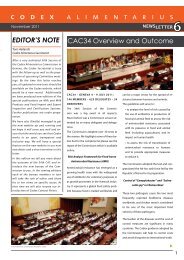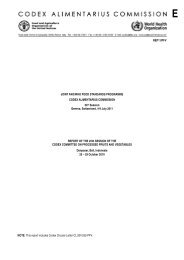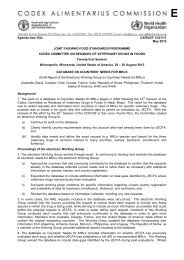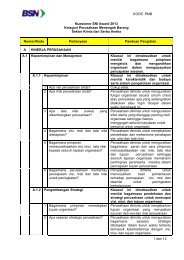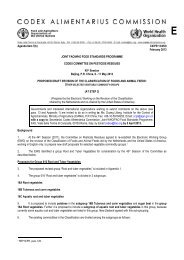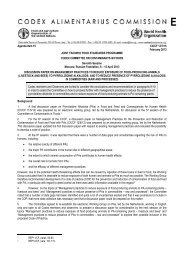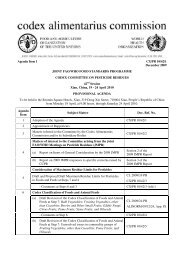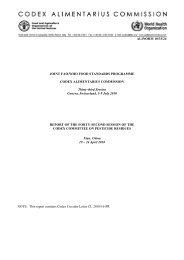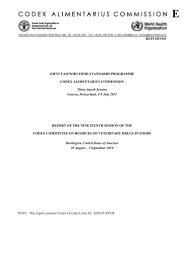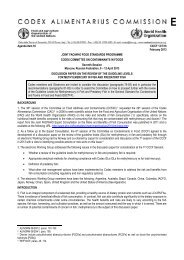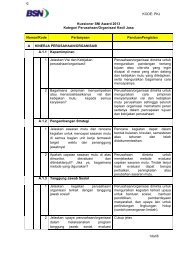alinorm 10/33/41 - CODEX Alimentarius
alinorm 10/33/41 - CODEX Alimentarius
alinorm 10/33/41 - CODEX Alimentarius
You also want an ePaper? Increase the reach of your titles
YUMPU automatically turns print PDFs into web optimized ePapers that Google loves.
ALINORM <strong>10</strong>/<strong>33</strong>/<strong>41</strong> 12Acrylamide<strong>10</strong>5. The Committee considered the proposals of the working group and agreed with the recommendations to:Arsenic• Encourage the use of the Code of Practice to reduce acrylamide formation;• To stimulate research on the mitigation measures and their impact on acrylamide production;• To reconsider work on acrylamide in future to allow sufficient time for the implementation of the Code ofPractice.<strong>10</strong>6. It was reported that JECFA had withdrawn the PTWI indicating that it does not adequately protect humanhealth and had emphasized that exposure to inorganic arsenic was strongly related to its presence in drinkingwater. Arsenic in food resulting from irrigation and cooking water can seriously contribute to the total intake andin this regard the proposal of Iran for new work on MLs for arsenic in rice had been considered. Due to sometechnical details in their proposal not being very clear, the WG recommended that a discussion paper on thefeasibility of establishing MLs in rice be developed.<strong>10</strong>7. The Committee agreed that an electronic Working Group, led by China and working in English, wouldprepare a discussion paper that would review the current state of knowledge and provide a summary of possiblerisk management options including the feasibility of setting MLs in rice for consideration at the next session.Deoxynivalenol (DON)<strong>10</strong>8. The Committee recalled that work on MLs for DON was discontinued by the Committee on Food Additivesand Contaminants (CCFAC) in 2004 due to lack of available occurrence data and that the development of adiscussion paper was started in 2005. This work was discontinued in 2007. In view of the availability of sufficientdata and the evaluation by JECFA, the Committee agreed with the recommendation to restart work on MLs forDON and its acetylated derivatives in cereals and cereal-based products.<strong>10</strong>9. It was clarified that this work on DON was only relevant to cereals for human consumption and not feed.The JECFA Secretariat indicated that it was unlikely that animals would consume feed with high DON levels, asDON induces emesis. Consideration for a discussion paper on DON transfer from animal feed to food for humanconsumption was given, but no decision was taken on this matter.1<strong>10</strong>. The Committee agreed that the Delegation of Canada would prepare a project document for submissionthrough the Secretariat to the 63 rd Executive Committee for consideration. Subject to approval of the Commission,the proposed draft Maximum Levels for DON and its acetylated derivatives in cereals and cereal-based productswould be prepared by an electronic Working Group led by the Delegation of Canada, working in English, forcirculation at Step 3 for comments and consideration at the next session.Risk management guidance111. The Committee considered the proposal of the working group for the development of guidance for riskmanagement options on how to deal with the results from new risk assessment methodologies. It was agreed thatan electronic Working Group, working in English and led by the Delegation of the United States of Americawould prepare a discussion paper concerning risk management options in relation to new risk assessmentoutcomes.MLs for total aflatoxins in dried figs112. The Committee considered the proposal for establishment of MLs for total aflatoxins in dried figs preparedby the Delegation of Turkey (CRD 7). Several delegations supported the proposal. One delegation questioned theneed for MLs at this point and was of the view that sufficient time should be given to the implementation of theCode of Practice for the Prevention and Reduction of Aflatoxin Contamination in Dried Figs. Another delegationpointed out that according to the principles for establishment of MLs in the GSCTFF, MLs should only beestablished when there was a real public health need and that according to JECFA dried figs only contributed to asmall percentage of total dietary intake and therefore more justification for this new work was needed.113. The Delegation of Turkey clarified that it had generated data following the implementation of the Code ofPractice and that this data would be considered in the development of the MLs. Accordingly paragraph 3 of theproject document was revised to take this into account.



